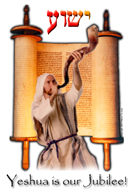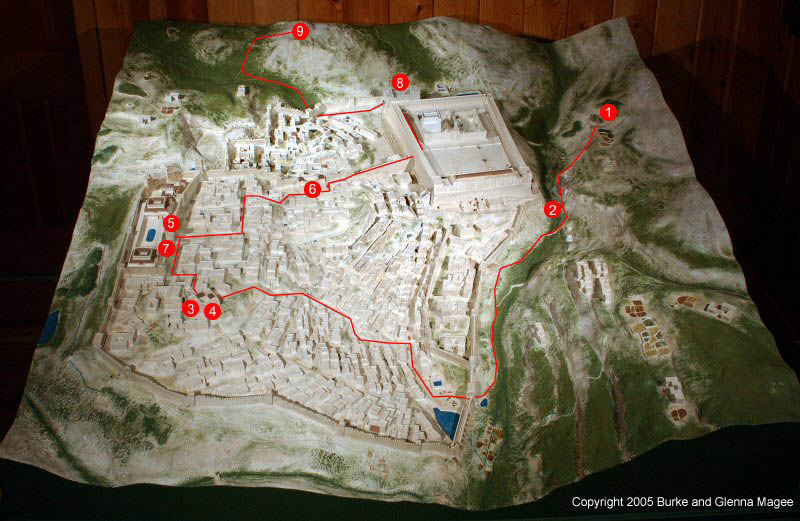

“He was oppressed, and he was afflicted, yet he opened not his mouth: he is brought as a lamb to the slaughter, and as a sheep before her shearers is dumb, so he openeth not his mouth.” - Isaiah 53:7
This scenario of Yeshua's trial was taken from Scripture. The exact
location of the various sites is not known. Therefore, some assumptions
have been made as to the locations where Yeshua was taken during His
many trials and crucifixion.
See text beneath image...

1) Yeshua was arrested in the Garden of Gethsemane (Matthew 26:47). [center picture 22]
2) Yeshua crossed the Kidron Valley (Valley of the Shadow of Death), likely reciting the 23rd Psalm, that was likely prophetic of this. [center picture 4]
3) Yeshua was taken to Annas (John 18:13). According to John 18:13, Yeshua was brought first to Annas after His arrest, and then questioned by Caiaphas. The location of Annas' house hasn't been positively identified. Josephus located it in the Upper City, south of Herod's palace, where the ruling class/wealthy lived. The dwelling we identify on our model has a courtyard. Generally, courtyards were accessible from the street. This could be the courtyard where Peter denied Yeshua (Luke 22:55-62). [center picture 8]
4) Yeshua was taken to Caiaphas. Since Annas had been the high priest until fifteen years before, it is very likely that Annas had continued to live in his residence and Caiaphas moved in when he became high priest. Thus it was likely Yeshua was examined by Caiaphas (and possibly the Sanhedrin) there after seeing Annas (Matthew 26:57, John 18:24). It would be convenient if Caiaphas lived in the same home as these dwellings had separate, but connected, family dwellings. [center picture 8]
5) Yeshua was taken to Pilate at “the Praetorium.” It's not clear where “the Praetorium” was located. It could be the palace of Herod the Great, where Pilate was said to have often stayed, and which was under Roman control at this time. Alternatively, “the Praetorium” could be in the fortress Antonia, which Herod the Great had named in honor of his patron, Marc Antony, and which served as the base of Roman authority in Jerusalem. In this case, we will assume the “Praetorium” referred to in John 18:28 is the palace of Herod the Great. At the time of Yeshua’s trial, Pilate was accompanied by his wife to Jerusalem. It is almost certain that, because of this, Pilate stayed in Herod’s Palace [center picture 9] rather than in the more spartan Fortress Antonia.
6) Yeshua was taken to Herod Antipas, Herod the Great's son, who likely lived at the Hasmonean Palace (Luke 23:7). [center picture 10]
7) Yeshua was taken back to Pilate (Luke 23:11). [center picture 9]
8) Yeshua was taken to the Fortress Antonia. It is possible that the Roman soldiers played the Roman game “Swords and Kings” with Yeshua. This is based on the descriptions given in Matthew 27:28, Mark 15:17 and John 19:2 that speak of the guards dressing Yeshua as a King with a crown of thorns, a purple robe, etc. The Roman game, “Swords and Kings,” is a perversion of a children’s game where children dress one child as a king. The Roman game also involved dressing the prisoner like a king with a purple robe and crown of thorns, but the guards would beat and taunt the prisoner until they reached the point in the game where the prisoner was taken out and crucified. “Swords and Kings” was so cruel that it was banned in Rome. [center picture 11]
9) Yeshua was crucified on Golgotha (north of the Altar, in keeping with Leviticus 1:11 that indicates that sacrifices should be slain north of the Altar). [center picture 23]